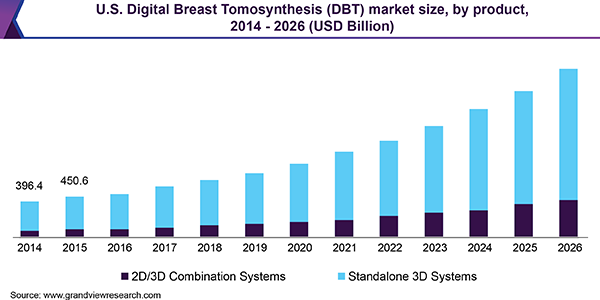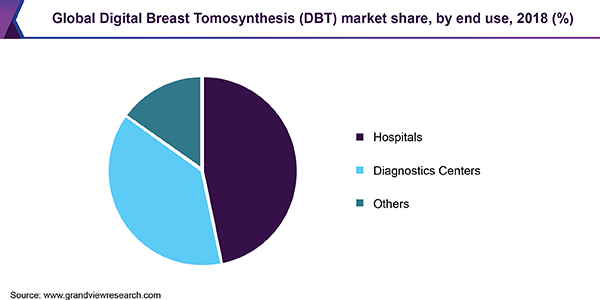
数字乳腺mosynthesis Market Size, Share & Trends Analysis Report By End Use (Diagnostic Centers, Hospitals), By Product (2D/3D Combination, Standalone 3D), By Region, And Segment Forecasts, 2019 - 2026
- Report ID: GVR-3-68038-212-9
- Number of Pages: 79
- Format: Electronic (PDF)
- Historical Range: 2014 - 2017
- Industry:Healthcare
Report Overview
The global digital breast tomosynthesis market size was valued at USD 1.41 billion in 2018 and is projected to expand at a CAGR of 13.5% over the forecast period. This growth can be attributed to technological advancements, rising awareness about the use of tomosynthesis, and increasing cases of breast cancer across the globe.

For instance, as per the World Health Organization (WHO) in 2018, breast cancer affected around 627,000 women globally and it is also estimated that the disease occurrence is higher in the developed regions than developing regions. The disease screening with DBT is much more convenient and efficient than 2D mammogram owing to which the demand for such products is expected to increase over the forecast period.
For instance, as per the American Journal of Roentgenology (AJR), in 2014, the relative change in recall rate was 16.1% lower in the patients screened with 3D digital breast tomosynthesis than the patients screened with the 2D digital mammogram. Therefore, such factors are anticipated to propel the market growth over the forecast period.
Increasing awareness about the benefits of DBT over the traditional systems is also expected to boost the market growth.
For instance, as per the Konica Minolta Healthcare Americas, Inc., in 2016, efficiency level has increased to almost 50.0% in DBT screening of invasive cancer. Key companies are investing more for product and technological developments for better efficiency and precision, which is also contributing to the digital breast tomosynthesis market growth. For instance, in March 2019, Fujifilm launched three new software tools for its product, ASPIRE Cristalle Digital Mammography System, for better efficiency.
Product Insights
On the basis of product, the market is segmented into 2D/3D combination and standalone 3D systems. Standalone 3D systems was the dominant product segment in 2018. Increasing prevalence of breast cancer across the globe and awareness about standalone DBT 3D systems are the key factors driving the segment. For instance, as per the American Cancer Society, in 2017, around 63,410 in situ cases and 252,710 invasive cases of breast cancer were reported in the U.S.
Furthermore, according to the report published by the Konica Minolta Healthcare Americas, Inc., standalone 3D systems can overcome the limitations of 2Dmammographysystems in terms of precision, efficiency, and sensitivity, thereby propelling the segment growth. 2D/3D combination systems segment is expected to witness the fastest growth over the forecast period. Rising awareness about the use of these systems is one of the key driving factors for the segment.
As per the study published by the American Society of Clinical Oncology (ASCO), in 2016, 2D/3D combination systems detected around 5.5 cancer cases per 1,000 women whereas around 4.3 cancer cases were detected with 2D mammography systems, which is almost 28.0% higher detection rate and 16.0% lower recall rate.
End-Use Insights
On the basis of end-use, the market is segmented into hospitals, diagnostic centers, and others. The hospitals segment dominated the market in 2018 owing to increasing healthcare expenditure in the developing countries and rising prevalence of breast cancer across the globe. For instance, as per the India Brand Equity Foundation, in 2018, the Indian hospital industry is anticipated to generate revenue of USD 132.84 billion by 2022. Such factors are expected to positively impact the segment growth over the forecast period.

Diagnostics centers segment is expected to witness the fastest growth over the forecast period. Rising number of diagnostics centers across the globe is anticipated to boost the segment growth. For instance, as per the India Brand Equity Foundation, in 2018, between April 2000 and December 2018, Foreign Direct Investment (FDI) made an investment of around USD 6.0 billion on hospitals and diagnostics centers.
区域的见解乐鱼APP二维码
在2018年北美主导全球市场and is expected to maintain its dominance over the forecast period. Rising incidence of breast cancer is one of the major driving factors for the North America regional market. In addition, the presence of highly developed healthcare infrastructure and increasing healthcare spending in the region is anticipated to propel the market growth. Asia Pacific is anticipated to be the fastest-growing regional market over the forecast period as key companies are trying to enter the emerging countries of the region.
数字乳腺mosynthesis Market Share Insights
Prominent companies in the market include Hologic, Inc.; GE Healthcare; Siemens Healthineers; Dexela Ltd.; and Fujifilm Corp. These companies have adopted strategies, such as product development, merger & acquisitions, and partnerships to strengthen their foothold in the market.
For instance, in April 2015, True Breast Tomosynthesis of Siemens Healthineers received FDA approval, which helped the company to increase its customer base. In addition, in September 2014, 3D breast imaging of GE healthcare got the FDA approval, which further accelerated the demand for 3D breast tomosynthesis imaging system.
数字乳腺mosynthesis Market Report Scope
Report Attribute |
Details |
Market size value in 2020 |
USD 1.80 billion |
Revenue forecast in 2026 |
USD 3.89 billion |
Growth Rate |
CAGR of 13.5% from 2019 to 2026 |
Base year for estimation |
2018 |
Historical data |
2014 - 2017 |
Forecast period |
2019 - 2026 |
Quantitative units |
Revenue in USD million and CAGR from 2019 to 2026 |
Report coverage |
Revenue forecast, company share, competitive landscape, growth factors and trends |
Segments covered |
Product, end-use, region |
Regional scope |
北美;欧洲;亚太地区;拉丁美洲; MEA |
Country scope |
U.S.; Canada; U.K.; Germany; Japan; China; Brazil; Mexico; South Africa; Saudi Arabia |
Key companies profiled |
Hologic Inc.; GE Healthcare; Siemens Healthineers; Dexela Ltd.; Fujifilm Corporation |
Customization scope |
Free report customization (equivalent up to 8 analysts working days) with purchase. Addition or alteration to country, regional & segment scope. |
Pricing and purchase options |
Avail customized purchase options to meet your exact research needs.Explore purchase options |
Segments Covered in the Report
This report forecasts revenue growth at global, regional, and country levels and provides an analysis of the latest industry trends in each of the sub-segments from 2014 to 2026. For the purpose of this study, Grand View Research has segmented the global digital breast tomosynthesis market report on the basis of product, end-use, and region:
Product Outlook (Revenue, USD Million, 2014 - 2026)
2D/3D Combination Systems
Standalone 3D Systems
End-Use Outlook (Revenue, USD Million, 2014 - 2026)
Hospitals
Diagnostics Centers
Others
Regional Outlook (Revenue, USD Million, 2014 - 2026)
North America
The U.S.
Canada
Europe
The U.K.
Germany
Asia-Pacific
Japan
China
拉丁美洲
Brazil
Mexico
MEA
South Africa
Saudi Arabia





